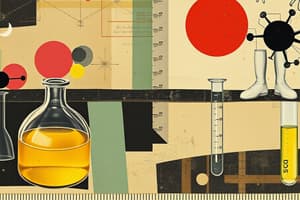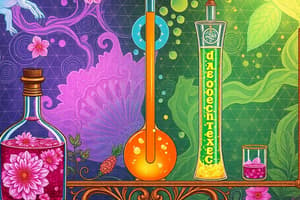Podcast
Questions and Answers
What is the pH range that indicates a basic solution?
What is the pH range that indicates a basic solution?
- 0 to 6
- 7 to 14 (correct)
- 6 to 7
- 7
Acids turn blue litmus paper red.
Acids turn blue litmus paper red.
True (A)
Name a common acid found in citrus fruits.
Name a common acid found in citrus fruits.
ascorbic acid
A solution with a pH of 7 is considered ______.
A solution with a pH of 7 is considered ______.
Match the following properties with acids or bases:
Match the following properties with acids or bases:
What is the pH range of acidic solutions?
What is the pH range of acidic solutions?
A solution with a pH of 9 is more acidic than a solution with a pH of 10.
A solution with a pH of 9 is more acidic than a solution with a pH of 10.
What is the formula to calculate pH from hydrogen ion concentration?
What is the formula to calculate pH from hydrogen ion concentration?
When [H+] = [OH-], the solution is considered __________.
When [H+] = [OH-], the solution is considered __________.
Match the following pH values with their corresponding acidity/basicity:
Match the following pH values with their corresponding acidity/basicity:
If the concentration of H+ ions is $1 x 10^{-4} M$, what is the pH?
If the concentration of H+ ions is $1 x 10^{-4} M$, what is the pH?
The pOH of a solution can be found by using the equation: pOH = 14 - pH.
The pOH of a solution can be found by using the equation: pOH = 14 - pH.
The pH and pOH together always sum up to __________.
The pH and pOH together always sum up to __________.
What is the pH of a solution where [H+] = $1 imes 10^{-10}$ M?
What is the pH of a solution where [H+] = $1 imes 10^{-10}$ M?
[OH-] increases in a solution with a pH less than 7.
[OH-] increases in a solution with a pH less than 7.
What is the pOH of a solution if the pH is 11?
What is the pOH of a solution if the pH is 11?
A Brønsted–Lowry _____ donates H+ ions.
A Brønsted–Lowry _____ donates H+ ions.
In the reaction HNO3(aq) + H2O(l) → H3O+(aq) + NO3−(aq), which species acts as the Brønsted–Lowry acid?
In the reaction HNO3(aq) + H2O(l) → H3O+(aq) + NO3−(aq), which species acts as the Brønsted–Lowry acid?
Match the following substances with their function in the Brønsted–Lowry theory:
Match the following substances with their function in the Brønsted–Lowry theory:
PH values greater than 7 indicate a basic solution.
PH values greater than 7 indicate a basic solution.
In aqueous solutions, bases produce ______ ions.
In aqueous solutions, bases produce ______ ions.
What is the conjugate base of H2SO4?
What is the conjugate base of H2SO4?
Amphoteric substances can only act as acids.
Amphoteric substances can only act as acids.
Identify the conjugate acid of NH3.
Identify the conjugate acid of NH3.
Water is considered an __________ substance due to its ability to act as both an acid and a base.
Water is considered an __________ substance due to its ability to act as both an acid and a base.
Match the following acids to their conjugate bases:
Match the following acids to their conjugate bases:
In the reaction H2O + NH3, what is the conjugate acid formed?
In the reaction H2O + NH3, what is the conjugate acid formed?
The conjugate pair of NO2− is HNO2.
The conjugate pair of NO2− is HNO2.
What happens to H2O when it reacts with a stronger acid?
What happens to H2O when it reacts with a stronger acid?
Flashcards are hidden until you start studying
Study Notes
pH Scale
- pH quantifies the acidity or basicity of a solution, ranging from 0 (strongly acidic) to 14 (strongly basic).
- Solutions with a pH below 7 are acidic, those at pH 7 are neutral (pure water), and pH above 7 indicates basicity.
- pH is determined by hydrogen ion concentration; more H+ ions correlate with lower pH and greater acidity.
- Hydroxide ions relate inversely; higher OH- concentrations result in higher pH and greater basicity.
- pH and pOH add up to 14, allowing interconversion between these measures.
Acids
- Acids release H+ ions in an aqueous solution; more H+ means greater acidity.
- Common acids include HCl (hydrochloric acid), HNO3 (nitric acid), vinegar, and citric fruits.
- Characteristic properties of acids: taste sour, are corrosive, and turn blue litmus paper red.
Bases
- Bases produce OH- ions in solution; they are known as alkaline substances.
- Notable bases include NaOH (sodium hydroxide) and Ca(OH)2 (calcium hydroxide).
- Bases feel slippery, taste bitter, are corrosive, and turn red litmus paper blue.
Calculating pH and pOH
- pH is calculated using the formula pH = -log[H+]. For example, a 0.01 M HCl solution yields a pH of 2.
- Each unit decrease in pH represents a tenfold increase in H+ concentration.
- pOH is calculated similarly using OH- concentration, and pH can be found with 14 - pOH.
- For bases, if a solution has 0.01 M NaOH, the pOH is 2, leading to a pH of 12.
Brønsted–Lowry Theory
- Defines acids as H+ donors and bases as H+ acceptors.
- Example: In the reaction of NH3 with water, NH3 accepts H+ while H2O donates it.
Conjugate Acid-Base Pairs
- Conjugate pairs consist of an acid and its corresponding base after it donates H+.
- Example: In the equilibrium reaction, HNO3 and H2O produce NO3− and H3O+. Here, HNO3 acts as an acid, while H2O is the base.
Amphoteric Substances
- Substances that can act as both acids and bases are termed amphoteric.
- Water is a prime example, donating H+ when interacting with bases and accepting H+ when acting with acids.
Summary of Acid-Base Characteristics
- Acids: sour taste, produce H+, turn litmus red.
- Bases: bitter taste, produce OH−, turn litmus blue.
- Conjugate relationships arise upon H+ transfer, demonstrating the dynamic nature of acid-base interactions.
Studying That Suits You
Use AI to generate personalized quizzes and flashcards to suit your learning preferences.




